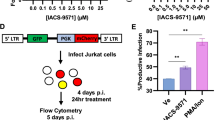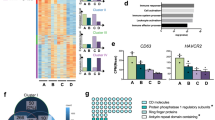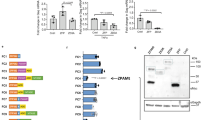Abstract
HIV-1 latency remains the primary obstacle to the eradication of this virus. The current latency-reversing agents cannot effectively and specifically eliminate latent HIV-1 reservoirs. Therefore, better approaches are urgently needed. In this study, we describe a novel strategy to reactivate latent HIV-1 using zinc-finger transcription factors composed of designer zinc-finger proteins and the transcriptional activation domain VP64. For the first time, we demonstrate that ZF-VP64 with HIV-1 long terminal repeat (LTR) promoter-specific affinity could significantly reactivate HIV-1 expression from latently infected cells without altering cell proliferation or cell cycle progression. We also provide evidence that the reactivation of HIV-1 by ZF-VP64 occurs through specific binding to the 5′-LTR promoter. Our results demonstrate the potential of this novel approach for anti-HIV-1 latency therapy.
This is a preview of subscription content, access via your institution
Access options
Subscribe to this journal
Receive 12 print issues and online access
$259.00 per year
only $21.58 per issue
Buy this article
- Purchase on Springer Link
- Instant access to full article PDF
Prices may be subject to local taxes which are calculated during checkout





Similar content being viewed by others
Accession codes
References
Richman DD, Margolis DM, Delaney M, Greene WC, Hazuda D, Pomerantz RJ . The challenge of finding a cure for HIV infection. Science 2009; 323: 1304–1307.
Katlama C, Deeks SG, Autran B, Martinez-Picado J, van Lunzen J, Rouzioux C et al. Barriers to a cure for HIV: new ways to target and eradicate HIV-1 reservoirs. Lancet 2013; 381: 2109–2117.
Deeks SG, Autran B, Berkhout B, Benkirane M, Cairns S, Chomont N et al. Towards an HIV cure: a global scientific strategy. Nat Rev Immunol 2012; 12: 607–614.
Van Lint C, Bouchat S, Marcello A . HIV-1 transcription and latency: an update. Retrovirology 2013; 10: 67.
Sgarbanti M, Battistini A . Therapeutics for HIV-1 reactivation from latency. Curr Opin Virol 2013; 3: 394–401.
Xing S, Siliciano RF . Targeting HIV latency: pharmacologic strategies toward eradication. Drug Discov Today 2012; 18: 541–551.
Karn J . The molecular biology of HIV latency: breaking and restoring the Tat-dependent transcriptional circuit. Curr Opin HIV AIDS 2011; 6: 4–11.
Bae KH, Do Kwon Y, Shin HC, Hwang MS, Ryu EH, Park KS et al. Human zinc fingers as building blocks in the construction of artificial transcription factors. Nat Biotechnol 2003; 21: 275–280.
Beerli RR, Dreier B, Barbas CF . III. Positive and negative regulation of endogenous genes by designed transcription factors. Proc Natl Acad Sci USA 2000; 97: 1495–1500.
Rebar EJ, Huang Y, Hickey R, Nath AK, Meoli D, Nath S et al. Induction of angiogenesis in a mouse model using engineered transcription factors. Nat Med 2002; 8: 1427–1432.
Beerli RR, Barbas CF . Engineering polydactyl zinc-finger transcription factors. Nat Biotechnol 2002; 20: 135–141.
Lara H, Wang Y, Beltran AS, Juárez-Moreno K, Yuan X, Kato S et al. Targeting serous epithelial ovarian cancer with designer zinc finger transcription factors. J Biol Chem 2012; 287: 29873–29886.
Wilson KA, Chateau ML, Porteus MH . Design and development of artificial zinc finger transcription factors and zinc finger nucleases to the hTERT locus. Mol Ther Nucleic Acids 2013; 2: e87.
Sera T . Zinc-finger-based artificial transcription factors and their applications. Adv Drug Deliver Rev 2009; 61: 513–526.
Beltran A, Liu Y, Parikh S, Temple B, Blancafort P . Interrogating genomes with combinatorial artificial transcription factor libraries: asking zinc finger questions. Assay Drug. Dev. Technol 2006; 4: 317–331.
Sadowski I, Ma J, Triezenberg S, Ptashne M . GAL4-VP16 is an unusually potent transcriptional activator. Nature 1988; 335: 563–564.
Segal DJ, Dreier B, Beerli RR, Barbas CF . III. Toward controlling gene expression at will: selection and design of zinc finger domains recognizing each of the 5′-GNN-3′ DNA target sequences. Proc Natl Acad Sci USA 1999; 96: 2758–2763.
Ruben SM, Dillon PJ, Schreck R, Henkel T, Chen CH, Maher M et al. Isolation of a rel-related human cDNA that potentially encodes the 65-kD subunit of NF-kappa B. Science 1991; 251: 1490–1493.
Margolin JF, Friedman JR, Meyer WK, Vissing H, Thiesen HJ, Rauscher FJ . III. Krüppel-associated boxes are potent transcriptional repression domains. Proc Natl Acad Sci USA 1994; 91: 4509–4513.
Magnenat L, Blancafort P, Barbas CF . III. In vivo selection of combinatorial libraries and designed affinity maturation of polydactyl zinc finger transcription factors for ICAM-1 provides new insights into gene regulation. J Mol Biol 2004; 341: 635–649.
Xu GL, Bestor TH . Cytosine methylation targetted to pre-determined sequences. Nat Genet 1997; 17: 376–378.
Bushman FD, Miller MD . Tethering human immunodeficiency virus type 1 preintegration complexes to target DNA promotes integration at nearby sites. J Virol 1997; 71: 458–464.
Kim YG, Cha J, Chandrasegaran S . Hybrid restriction enzymes: zinc finger fusions to Fok I cleavage domain. Proc Natl Acad Sci USA 1996; 93: 1156–1160.
Jamieson AC, Miller JC, Pabo CO . Drug discovery with engineered zinc-finger proteins. Nat Rev Drug Discov 2003; 2: 361–368.
Reynolds L, Ullman C, Moore M, Isalan M, West MJ, Clapham P et al. Repression of the HIV-1 5′ LTR promoter and inhibition of HIV-1 replication by using engineered zinc-finger transcription factors. Proc Natl Acad Sci USA 2003; 100: 1615–1620.
Segal DJ, Gonçalves J, Eberhardy S, Swan CH, Torbett BE, Li X et al. Attenuation of HIV-1 replication in primary human cells with a designed zinc finger transcription factor. J Biol Chem 2004; 279: 14509–14519.
Kim YS, Kim JM, Jung DL, Kang JE, Lee S, Kim JS et al. Artificial zinc finger fusions targeting Sp1-binding sites and the trans-activator-responsive element potently repress transcription and replicationof HIV-1. J Biol Chem 2005; 280: 21545–21552.
Eberhardy SR, Goncalves J, Coelho S, Segal DJ, Berkhout B, Barbas CF . III. Inhibition of human immunodeficiency virus type 1 replication with artificial transcription factors targeting the highly conserved primer-binding site. J Virol 2006; 80: 2873–2883.
Marciniak RA, Calnan BJ, Frankel AD, Sharp PA . HIV-1 Tat protein trans-activates transcription in vitro. Cell 1990; 63: 791–802.
Wei P, Garber ME, Fang S-M, Fischer WH, Jones KA . A novel CDK9-associated C-type cyclin interacts directly with HIV-1 Tat and mediates its high-affinity, loop-specific binding to TAR RNA. Cell 1998; 92: 451–462.
Muniz L, Egloff S, Ughy B, Jády BE, Kiss T . Controlling cellular P-TEFb activity by the HIV-1 transcriptional transactivator Tat. PLoS Pathog 2010; 6: e1001152.
Ding D, Qu X, Li L, Zhou X, Liu S, Lin S et al. Involvement of histone methyltransferase GLP in HIV-1 latency through catalysis of H3K9 dimethylation. Virology 2013; 440: 182–189.
Cohen N, Mouly E, Hamdi H, Maillot M-C, Pallardy M, Godot V et al. GILZ expression in human dendritic cells redirects their maturation and prevents antigen-specific T lymphocyte response. Blood 2006; 107: 2037–2044.
Gräslund T, Li X, Magnenat L, Popkov M, Barbas CF . Exploring strategies for the design of artificial transcription factors targeting sites proximal to known regulatory regions for the induction oF γ-globin expression and the treatment of sickle cell disease. J Biol Chem 2005; 280: 3707–3714.
Qu X, Wang P, Ding D, Li L, Wang H, Ma L et al. Zinc-finger-nucleases mediate specific and efficient excision of HIV-1 proviral DNA from infected and latently infected human T cells. Nucleic Acids Res 2013; 41: 7771–7782.
Qi LS, Larson MH, Gilbert LA, Doudna JA, Weissman JS, Arkin AP et al. Repurposing CRISPR as an RNA-guided platform for sequence-specific control of gene expression. Cell 2013; 152: 1173–1183.
Ying H, Zhang Y, Zhou X, Qu X, Wang P, Liu S et al. Selective histonedeacetylase inhibitor M344 intervenes in HIV-1 latency through increasing histone acetylation and activation of NF-kappaB. PLoS One 2012; 7: e48832.
Wang P, Qu X, Wang X, Liu L, Zhu X, Zeng H et al. As2O3 synergistically reactivate latent HIV-1 by induction of NF-κB. Antiviral Res 2013; 100: 688–697.
Jordan A, Bisgrove D, Verdin E . HIV reproducibly establishes a latent infection after acute infection of T cells in vitro. EMBO J 2003; 22: 1868–1877.
Acknowledgements
We thank the NIH AIDS Research and Reference Reagent Program for providing the J-Lat clone A10.6 cells. We also thank Prof Jianqing Xu (Shanghai Medical College of Fudan University) for providing the pNL4-3-EGFP plasmid. This work was supported by the National Grand Program on Key Infectious Disease (2014ZX10001003) and National Natural Science Foundation of China (31271418 to H Zhu).
Author information
Authors and Affiliations
Corresponding author
Ethics declarations
Competing interests
The authors declare no conflict of interest.
Additional information
Supplementary Information accompanies this paper on Gene Therapy website
Supplementary information
Rights and permissions
About this article
Cite this article
Wang, P., Qu, X., Wang, X. et al. Specific reactivation of latent HIV-1 with designer zinc-finger transcription factors targeting the HIV-1 5′-LTR promoter. Gene Ther 21, 490–495 (2014). https://doi.org/10.1038/gt.2014.21
Received:
Revised:
Accepted:
Published:
Issue Date:
DOI: https://doi.org/10.1038/gt.2014.21
This article is cited by
-
Molecular Mechanisms of HIV-1 Latency from a Chromatin and Epigenetic Perspective
Current Clinical Microbiology Reports (2023)
-
Reactivation of HIV-1 from Latency by an Ingenol Derivative from Euphorbia Kansui
Scientific Reports (2017)
-
Specific Reactivation of Latent HIV-1 by dCas9-SunTag-VP64-mediated Guide RNA Targeting the HIV-1 Promoter
Molecular Therapy (2016)
-
The BET inhibitor OTX015 reactivates latent HIV-1 through P-TEFb
Scientific Reports (2016)
-
CRISPR-mediated Activation of Latent HIV-1 Expression
Molecular Therapy (2016)



